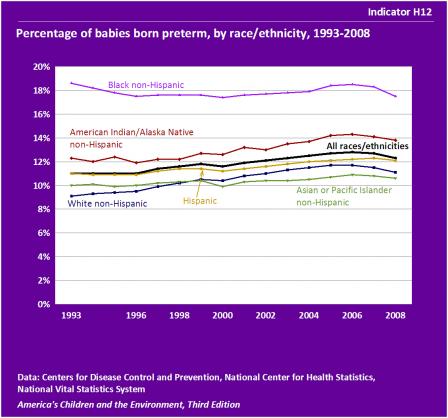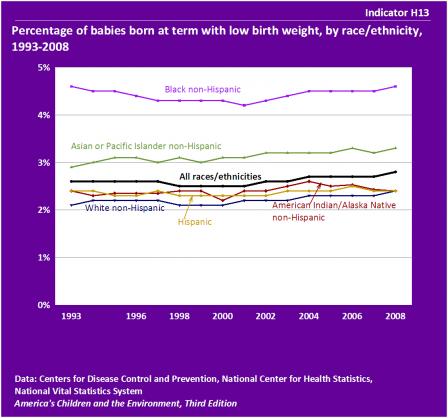About the Adverse Birth Outcomes Indicators
Indicators H12 and H13 present information about babies born preterm and those born with low birth weight. The data are from a vital statistics registration system that registers vital events including virtually all births in the United States.
- Indicator H12 presents the percentage of babies born preterm, by race/ethnicity, from 1993-2008.
- Indicator H13 presents the percentage of babies born at term with low birth weight, by race/ethnicity, from 1993-2008.
The period of gestation is a crucial determinant of an infant's health and survival for years to come. Two measures that may be used to understand the quality of an infant's gestation are length of gestation (pregnancy length) and birth weight. Normal term pregnancies last between 37 and 41 completed weeks: preterm birth is defined as a live birth before 37 completed weeks of gestation. Birth weight is determined by length of gestation and fetal growth (the rate at which an infant develops and increases in size). Low birth weight infants are defined as weighing less than 2,500 grams (about 5 pounds, 8 ounces).
A growing number of studies have examined the possible role that exposure to environmental contaminants may play in the causation of preterm birth and low birth weight. The Surgeon General has determined that exposure of pregnant women to environmental tobacco smoke (ETS) causes a small reduction in mean birth weight and the evidence is suggestive (but not sufficient to infer causation) of a relationship between maternal exposure to environmental tobacco smoke during pregnancy and preterm delivery. The Surgeon General has stated that there is no risk-free level of exposure to ETS. Additionally, the National Toxicology Program has concluded that maternal exposure to lead is known to cause reduced fetal growth, and that there is limited evidence of an association with preterm birth. Finally, some studies have reported associations between air pollution or other environmental contaminants and adverse birth outcomes. Preterm and low birth weight infants are at greater risk for mortality and a variety of health and developmental problems, both in childhood and adulthood.
Indicators H12 and H13 present data on preterm birth and low birth weight from the National Vital Statistics System (NVSS).
More information about obesity and Indicators H12 and H13 is provided in the Adverse Birth Outcomes section of America's Children and the Environment, Third Edition.
Related Links
Centers for Disease Control and Prevention (CDC): Maternal and Child Health Exit
Institute of Medicine (IOM): Preterm Birth: Causes, Consequences, and Prevention
National Toxicology Program (NTP): Health Effects of Low-Level Lead Evaluation
U.S. Department of Health & Human Services (HHS): The Health Consequences of Involuntary Exposure to Tobacco Smoke: A Report of the Surgeon General
U.S. EPA Integrated Science Assessment: Particulate Matter (PM)
Summary of Methods - Adverse Birth Outcomes
The National Center for Health Statistics, a division of the Centers for Disease Control and Prevention (CDC), maintains the National Vital Statistics System (NVSS) which compiles national data on gestational ages and birth weights from birth certificate registration data from states and other U.S. jurisdictions. The NVSS data are provided through contracts between the CDC and vital registration systems operated in each state, which are legally responsible for the registration of vital events including births, deaths, marriages, divorces, and fetal deaths. Birth certificates provide information on characteristics of both the infant and his/her parents, including the weight of the infant and the length of gestation. Length of gestation is recorded in completed weeks and is based on clinical estimation, usually from the date of the woman's last menstrual period or ultrasound.
Indicator H12 uses the NVSS data to present the percentage of babies born preterm (defined as a period of gestation less than 37 completed weeks) stratified by race/ethnicity. Indicator H13 uses the data to present the percentage of babies that are both born at term (defined as a period of gestation of at least 37 completed weeks) and have low birth weight (defined as a weight less than 2,500 grams), stratified by race/ethnicity.
Detailed Methods for Indicators H12 and H13
Metadata for National Health Interview Survey (NHIS)


